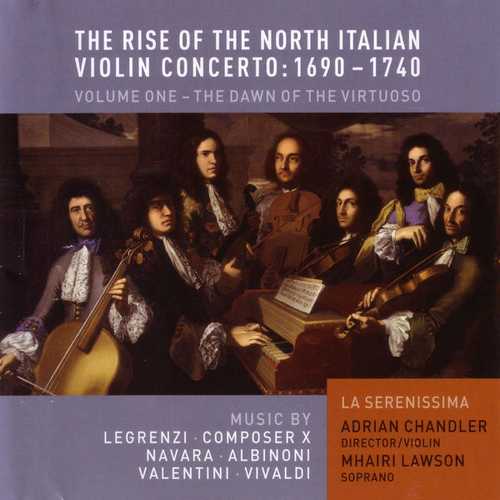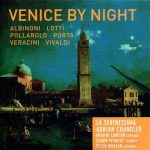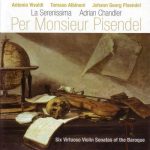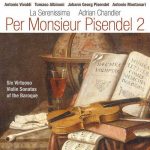
Composer: Tomaso Albinoni, Giovanni Legrenzi, Francesco Navara, Giuseppe Valentini, Antonio Vivaldi
Performer: La Serenissima, Mhairi Lawson
Conductor: Adrian Chandler
Format: FLAC (tracks)
Label: Avie
Catalogue: AV2106
Release: 2006
Size: 432 MB
Recovery: +3%
Scan: cover
01. Navara: Sinfonia / Sonata à 5 in C
02. Navara: Sinfonia / Sonata à 5 in C
03 .Navara: Sinfonia / Sonata à 5 in C
04. Navara: Sinfonia / Sonata à 5 in C
05. anon.: Laudate pueri Dominum à voce sola et 5 strumenti, RV Anh 30
06. anon.: Laudate pueri Dominum à voce sola et 5 strumenti, RV Anh 30
07. anon.: Laudate pueri Dominum à voce sola et 5 strumenti, RV Anh 30
08. anon.: Laudate pueri Dominum à voce sola et 5 strumenti, RV Anh 30
09. anon.: Laudate pueri Dominum à voce sola et 5 strumenti, RV Anh 30
10. anon.: Laudate pueri Dominum à voce sola et 5 strumenti, RV Anh 30
11. anon.: Laudate pueri Dominum à voce sola et 5 strumenti, RV Anh 30
12. anon.: Laudate pueri Dominum à voce sola et 5 strumenti, RV Anh 30
13. anon.: Laudate pueri Dominum à voce sola et 5 strumenti, RV Anh 30
14. anon.: Laudate pueri Dominum à voce sola et 5 strumenti, RV Anh 30
15. Legrenzi: 3 Balletti e Correnti à 5 from Op 16
16. Legrenzi: 3 Balletti e Correnti à 5 from Op 16
17. Legrenzi: 3 Balletti e Correnti à 5 from Op 16
18. Legrenzi: 3 Balletti e Correnti à 5 from Op 16
19. Legrenzi: 3 Balletti e Correnti à 5 from Op 16
20. Legrenzi: 3 Balletti e Correnti à 5 from Op 16
21. Navara: Sinfonia / Sonata à 5 in a
22. Navara: Sinfonia / Sonata à 5 in a
23. Navara: Sinfonia / Sonata à 5 in a
24. Navara: Sinfonia / Sonata à 5 in a
25. Albinoni: Concerto IV à 6 in G, Op 2 / 8
26. Albinoni: Concerto IV à 6 in G, Op 2 / 8
27. Albinoni: Concerto IV à 6 in G, Op 2 / 8
28. Valentini: Concerto XI à 6 con quattro violini obligati in a, Op 7
29. Valentini: Concerto XI à 6 con quattro violini obligati in a, Op 7
30. Valentini: Concerto XI à 6 con quattro violini obligati in a, Op 7
31. Valentini: Concerto XI à 6 con quattro violini obligati in a, Op 7
32. Valentini: Concerto XI à 6 con quattro violini obligati in a, Op 7
33. Valentini: Concerto XI à 6 con quattro violini obligati in a, Op 7
Vivaldi: Concerto, Op. 3 No. 3 ‘Con Violino Solo obligato’, RV 310
34. Allegro
35. Largo
36. Allegro
Vivaldi: Concerto, Op. 3 No. 10 ‘Con quattro Violini e Violoncello obligato’, RV 580
37. Allegro
38. Largo – Larghetto – Adagio – Largo
39. Allegro
It’s the late 1600s in Northern Italy. The great violin makers of Brescia and Cremona conspire with composers to satisfy a growing demand for instrumental music which reflected and in turn promoted increased technical capability of their instruments and proficiency among players. The resulting repertoire is a body of rich and virtuostic sinfonia, concerti and vocal works that influenced a generation of composers throughout continental Europe. There can be no greater modern day proponent of this output than Adrian Chandler, whose passion for the works of Vivaldi and his contemporaries shines through these virtuoso works by Albinoni, Legrenzi, Navara, Valenti, one Composer X and the Red Priest himself. Directing La Serenissima, the ensemble he founded in 1994, this is Adrian’s fourth recording for Avie and the first of three charting the development of the north Italian violin concerto between the years 1690 and 1740.
The Vivaldian violin concerto seems such a classically simple thing with its chunky tutti sharply differentiated from spectacular solos. And Vivaldi wrote so fluently, wrote so many hundreds of works, that it’s easy to assume he had solid preexisting models into which he needed only to pour his own inspiration. Listeners who have investigated the music of Torelli, Albinoni, and Corelli a bit know that it’s not so simple. And now this disc makes manifest the full complexity of the concerto’s early development. The project is the brainchild of British director and violinist Adrian Chandler and Vivaldi forms the tail end of the story told here. What was necessary to make the Baroque violin concerto, Chandler asks? The list turns out to be rather long.
It includes 1) the formation of a genuine string orchestra, 2) the expressive instrumental counterpoint of the Corellian trio sonata, 3) the emergence of the solo/tutti contrast, 4) the classic three-movement concerto structure, and 5) the virtuoso element, among other smaller details. The pieces on the disc, whose composers include the well-known (Vivaldi, Albinoni), the moderately well-known (Legrenzi), and the unknown (Francesco Navara, Giuseppe Valentini, and the “Composer X” who wrote the solo cantata Laudate pueri Dominum studied by the young Vivaldi. The inclusion of a vocal work makes perfect sense, for one obvious model for instrumental solos was operatic vocalism, and the performance of this work by soprano Mhairi Lawson is worth the purchase price by itself with its dramatic contrast between Lawson’s explosive voice and the tense, dry tones of Chandler’s ensemble La Serenissima.
The other works show how composers refined and simplified the variety of stylistic choices available to them at the end of the genuinely Baroque seventeenth century, even as they grew a basic five-part ensemble into something slightly larger and more variegated. The entire disc is worth hearing for those in search of anything from an enjoyable program of Baroque string music to a good starting point for a graduate-level seminar in Italian Baroque music.



